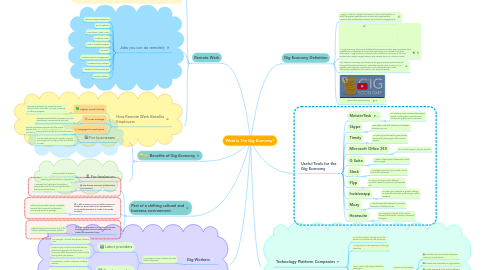
1. Remote Work
1.1. Definition
1.1.1. A remote job is one that is done away from the office in a remote location. This could be either work done from home, or work done on the road in the case of a job such as a Regional Salesperson.
1.1.2. See also: What is a remote job?
1.2. Jobs you can do remotely
1.2.1. Telecommuting/Teleworking
1.2.2. Email Marketer
1.2.3. Promotional Video Maker
1.2.4. Freelance Writer
1.2.5. Web or Graphic Designer
1.2.6. Translator
1.2.7. Customer Service Management
1.2.8. Crowdsourcing Manager
1.2.9. Android or iPhone Developer
1.2.10. E-Book Publisher
1.3. How Remote Work Benefits Employers
1.3.1. Higher productivity
1.3.1.1. Remote employees are almost twice as likely to work more than 40 hours a week as in-office employees
1.3.2. Cost savings
1.3.2.1. Flexjobs reported that employers can save $22,000 per remote worker per year
1.3.3. Engaged employees
1.3.3.1. remote employees reported that they were happier than non-remote employees and also felt more valued within their role
2. Benefits of Gig Economy
2.1. For businesses
2.1.1. Saving resources like time and office space
2.1.2. Contract with experts for specific projects who might be too high-priced to maintain on staff
2.2. For freelancer
2.2.1. Improve work-life balance
2.2.2. Selecting jobs that they're interested in
3. Part of a shifting cultural and business environment
3.1. The sharing economy (collaborative consumption)
3.1.1. A concept that highlights the ability of individuals to rent or borrow goods rather than buy and own them
3.2. A gift economy is one in which services or goods are given without an agreement as to a suitable payment or trade to be made in return.
3.2.1. Gift economies often rely on intangible rewards like a sense of contribution, community, honor or prestige
3.3. A barter economy is a cashless economic system in which services and goods are traded at negotiated rates
3.3.1. Barter-based economies are one of the earliest, predating monetary systems
4. Gig Workers
4.1. Gig workers can be classified into two broad categories:
4.1.1. Labor providers
4.1.1.1. For example – drivers, handymen, delivery men
4.1.1.2. Lower-income and less-educated workers who rely on gig work for their entire livelihood, often because they have trouble finding other job options.
4.1.2. Goods providers
4.1.2.1. For example – artists, craftsmen, clothing retailers
4.1.2.2. Higher-income and more-educated workers who do not depend on their gig work income, often because they have another full-time job; their gig work generally provides supplemental income.
5. Useful Tools for the Gig Economy
5.1. MeisterTask
5.1.1. For creating visual, Kanban-style project boards, inviting team members and collaborating with them in real-time.
5.2. Skype
5.2.1. Free video chats with clients and coworkers wherever you are.
5.3. Timely
5.3.1. For planing and scheduling your weeks ahead and tracking your time on each project.
5.4. Microsoft Office 365
5.4.1. All Microsoft Apps on all your devices.
5.5. G Suite
5.5.1. A suite of web-based collaboration tools from Google
5.6. Slack
5.6.1. A message service to connect with clients and other freelancers.
5.7. Flyp
5.7.1. For using one phone with different numbers. Good for personal und business use.
5.8. Invisionapp
5.8.1. For web, app, software or graphic design. To show the client the work and get instant feedback.
5.9. Mozy
5.9.1. A cloud based data backup for personal, business and enterprise use.
5.10. Hootsuite
5.10.1. For managing multiple social media networks like Twitter, LinkedIn, Facebook, Instagram.
6. Gig Economy Definition
6.1. A gig (= a task or a project) economy is a free market system in which temporary positions are common and organizations contract with independent workers for short-term engagements.
6.2. In a gig economy, temporary, flexible jobs are commonplace and companies tend toward hiring independent contractors and freelancers instead of full-time employees. A gig economy undermines the traditional economy of full-time workers who rarely change positions and instead focus on a lifetime career.
6.3. The freelance economy, also known as the gig economy, revolves around hiring self-employed workers to undertake specific jobs in return for an agreed upon payment. Freelancers are the individuals who make themselves available to be hired for such temporary work.
6.4. What is the Gig Economy?
7. Technology Platform Companies
7.1. Act as the medium through which the worker is connected to the consumer.
7.2. A major force in the expansion of the gig economy.
7.3. Uber, Airbnb, Lyft, Etsy, TaskRabbit, 99designs...
7.3.1. Distinct commonalities
7.3.1.1. Facilitate direct transactions between consumer and producer.
7.3.1.2. Flexible work schedules for gig workers.
7.3.1.3. Online payments, from which platforms take a cut.
7.3.1.4. Online profiles and reviews of both producers and consumers.
